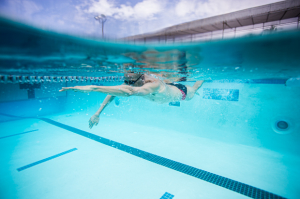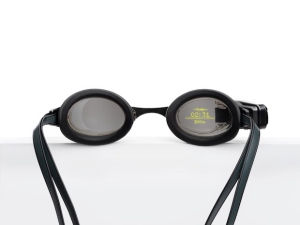
We’ve been touching upon many of the features and new launches of the FORM Swim product suite. But now we’re here having put the ecosystem through its paces over an extended period of time to give you a comprehensive review. I have had my set of goggles for nearly two and a half years and can speak to countless hours of swimming in pools, open water, and more with them to deliver this. To get an initial disclosure out of the way: yes, FORM is a partner of Slowtwitch. I bought my goggles at a 10% discount at the Endurance Exchange conference, but paid for them with my own money. And I apologize for the lack of decent pictures, but trying to get somebody else to take photos of me swimming while wearing the goggle proved…challenging.
At any rate: let’s dive in.
What Is It?
This has become a slightly more difficult thing to answer as of May 26, 2022. FORM has evolved from being a manufacturer of a swim goggle with a built-in heads up display to an entire swimming focused ecosystem, of which the goggle is merely one component. Think of FORM more like a WHOOP, for instance, and you’re in the right ballpark – the wearable good is merely the measurement tool that feeds into this ecosystem rather than the product for purchase.
The ecosystem consists of two main components: the FORM Swim goggle, and the FORM Swim app. The app is the primary controller of your user experience, containing all of the analytical and workout based tools that you would then use with your goggles. Your goggles, meanwhile, are your recording device during the course of the swim itself. The goggle itself is very similar to the Speedo Vanquisher in shape and gasket size, and comes with 9 different nose bridge pieces to find the best fit for you. It’s a smart decision in terms of style of goggle – it’s the most popular size and shape of goggle on the market, and it also gives a decent size for the heads-up display.

How Does It All Work?
Well, first, to be able to acquire the goggles, you need to purchase a membership, which is done exclusively through FORM. You can purchase a membership either on a month-to-month basis, which requires a six month minimum commitment, or you may purchase an annual subscription for $228 (Slowtwitchers receive a 20% discount on that price using the code SLOWTWITCH).
Your membership includes each part of the ecosystem:
–Smart Swim Goggles and Real-time metrics
–1,000+ Swim Workouts that can be loaded to the goggle
–20+ Swim plans (including our Guppy Challenge)
–Analysis via the FORM Swim app
Now, as mentioned above, there’s a key change that occurred as of May 26, 2022. If you are a legacy customer, like myself, your goggles will display real-time metrics regardless of whether or not you keep your membership. If you are joining as of today, though, you must maintain membership in order for you to keep real-time metrics. If you allow your membership to lapse, you will only be able to access a sampling of workouts, and will not be able to access any real-time metrics. This includes open-water mode.
Once you have your membership, the FORM Swim App is the key to the kingdom. You use the app to select, for instance, one of FORM’s training plans, or up to five workouts out of their library to send to the goggle. You may also use the App to control what metrics are displayed when using the goggle, or which google to display information in. It’s all a relatively seamless experience – not once during the course of 2.5 years did I ever experience any problem with syncing between the goggle and the app. The only technical failure that I experienced was that my FORM Swim app did not automatically update from the Apple Store, and there was a delay in my accessing a new premium feature. That’s it.
The goggles also come with a hard shell case. It is highly recommended that you use that case. My goggles, after 2.5 years of use, don’t even have a scratch in them. You’re also supposed to rinse the goggles out. Admittedly, I am less good at doing that as I am using the case. But after approximately 250 swims, the goggles don’t leak, don’t fog, don’t have a scratch in them. It’s a very premium set of goggles built to last. I can’t complain one word about them.

Swimming with FORM
As I mentioned in my getting started article, one nice little nugget was having a device that was ready to go, right out of the box. They were already halfway charged. No needing to plug it in, no real hard set-up. It was: open box. Turn on. Pair with the FORM Swim app. Go swim.
How simple is that?
Now, admittedly, I’m also a really simple swimmer. Unlike most Slowtwitchers, who either swim solo or are self-coached, I have a coach who writes my workouts and I have a good feel for the pace clock. So I wanted to keep my goggles, at least for myself, very simple. I set myself up to see pace per length and distance.
But let’s say that you’re not me. Let’s say you needed more of that swim coaching, and you were following a training plan (perhaps you’re using our Guppy Challenge). Well, that’s pretty simple and straightforward as well – select the training plan through the app, download it to your goggles, select the workout, and follow along to the instructions, right there inside of it. People who are either data-driven or immediate feedback driven can truly benefit from some of the work in here.
My personal favorite use case is for open-water swimming. Pair your selected Garmin or Polar device to the FORM app and away you go. The connection between the goggles and a watch is slightly more temperamental than that of the goggles to the app, for instance. If you’re a single side breather, for instance, you should wear the watch on the side you breathe on. Bilateral breather? Well…I never had an issue, but there have been other users who have noted issues. You should make sure that they are well paired on land before plunging into the water. That said, once you’re about to get into the water, stuff is simple. You can use either open-water mode or triathlon mode and you control everything from the watch. The goggles are just the display. If you’re in triathlon mode, switching to transition will power down the goggle display.
In terms of negatives, they are few and far between. There is obviously the ongoing cost of membership. Whether or not that is a value proposition for you is really determined by your current coaching relationship and what you find motivating while swimming. For me, personally, I think having some of the current training plans are beneficial, especially as I come back to swimming more. But I also do not know whether or not I would still value that as I do more workouts written specifically by my coach. The platform does not currently support syncing workouts from alternate sources (e.g., your coach writes you a workout in TrainingPeaks and you can sync that workout to your goggle). FORM knows this a function people are looking for – but whether or not it is forthcoming is to be determined.
The other negative that I have is very personal. As of this writing, we’ve just “celebrated” the 8 year anniversary of a massive cycling crash. One of the lingering side effects of that crash is a disconnect between what I’m seeing and what I’m able to actually process. My brain gets confused with the size of the information in my eye and what I’m attempting to process behind it, and I wind up either nauseous or dizzy. It is less of an issue with outdoor pools, or deeper pools. But my local Y is a three foot shallow section pool with a tiled floor, and it can make it challenging on my worst days to wear the goggle. I’d love the ability to adjust the size of the display like you can adjust which side you wear it on, or the brightness of it.
Final Thoughts
In total, FORM’s created a pretty compelling product and ecosystem. The most surprising thing, for me, is just how bulletproof the system has been. I’ve had precisely one FORM app crash on my iPhone, which required a deletion and reinstall of the application. The goggles have always worked flawlessly. They still don’t leak, and the display isn’t missing any pixels or is scratched. Considering what I would normally spend on pairs of goggles annually given how quickly many of them mold over or leak, I can’t complain about cost.
Whether that still would hold if I were paying for membership is a bit of another story. At just over $20 per month when purchasing membership annually, I can think of worse things that I have spent money on. (This reminds me to cancel the SiriusXM in my car, as much as I enjoy Lithium.) But I also can understand the questions behind that value. Ultimately, you have to answer that question yourself.



